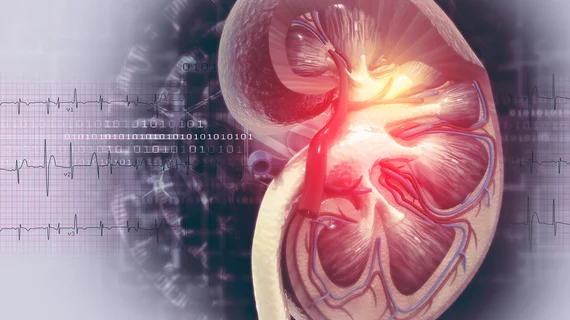High-dose radiation therapy safe, effective for kidney cancer patients with one kidney
Stereotactic radiation therapy is a safe and effective treatment for cancer patients with only one kidney, according to recent research presented Monday, Oct. 22, at the 2018 American Society for Radiation Oncology (ASTRO) annual meeting in San Antonio, Texas.
Traditionally, renal cell carcinoma is treated surgically, but stereotactic ablative radiotherapy (SABR)—also known as stereotactic body radiation therapy (SBRT)—has emerged as an alternative for patients with the disease. A study published earlier this year in Cancer showed SABR to be effective in treating kidney cancer patients with both organs remaining.
"Although RCC historically has been considered resistant to conventional radiation therapy, the high doses and high precision achievable with SABR overcome this resistance," said lead author Rohann J. M. Correa, MD, PhD, and radiation oncology resident at London Health Sciences Center in London, Canada, in a statement. “Our analysis demonstrates SABR to be highly effective with minimal side effects for RCC patients with a single kidney."
Correa and colleagues looked at the data of 223 patients who underwent renal SABR across nine locations in the U.S., Germany, Australia, Canada and Japan. Of the patient total, 81 had a single kidney. The median biologically-effective dose of radiation therapy was 87.5 Gray—the same for those in the bilateral group.
After a median follow-up of 2.6 years, SABR demonstrated 98 percent two-year local control and 98 percent two-year cancer-specific survival in RCC participants with one kidney. The rates were similar from those patients with both kidneys, according to the researchers. Overall survival was also similar between the two groups.
While renal function was slightly affected by SABR, the researchers were “somewhat surprised” the impact was not more significant, they said in the statement.
Overall, treating RCC patients with a single kidney is a unique challenge, but one the researchers believe is worth addressing.
"Recognizing the challenges of randomized controlled trials in this unique and somewhat-rare population, we hope that our large, international dataset will significantly advance the paradigm of kidney SABR, increasing awareness and access for patients facing this challenging management scenario," Correa concluded.

